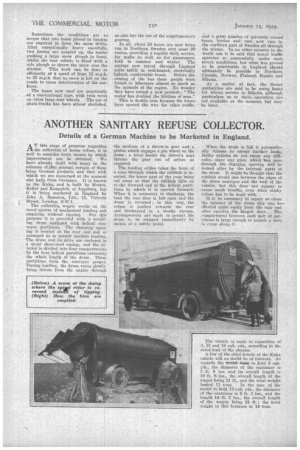ANOTHER SANITARY REFUSE COLLECTOR.
Page 28

If you've noticed an error in this article please click here to report it so we can fix it.
Details of a German Machine to be Marketed in England.
AT this stage of progress regarding the collection Of house refuse, it is well to consider every means by which improvement can be obtained. We have already dealt with many in the columns Of t-ltia•joarnal, certain of these being German products and that with -which we are concerned at the moment also hails from Germany. It is known as the Kuka, and is built by Messri. Keller and Knappich, of Augsburg, blit it is being marketed in England by John A. Smeeton, Ltd., 15, Victori Street, London, &W.1.
The collecting wagon works on tle novel system of mechanical loading and
emptying without tipping. For th's purpose it is provided with a revolving drum equipped with helical conveyor partitions. The charging opening is located at the rear end and Sc, arranged as to permit dustless loading. The drum and its drive are enclosed in a stout sheet-steel easing, and the i1tenor is divided into four compartmen by the four helical Partitions extencli the whole length of the drum. The. e partitions form the conveyor propeL. During loading, the drum turns slowlY. being driven from the engine throligh
the medium of a throw-in gear and a pinion which engages a pin wheel on the drum ; a lever beside the driver's seat throws the gear out of action as required.
The loading orifice takes the form of a cone through which the rubbish is'inserted, the lower part of the cone being cut away so that the • rubbish falls on to the forward end a. the helical partitions by which it is carried forward. When it is necessary to discharge the load the rear door is left open and the drum is reversed in this way, the refuse is pushed towards the rear and discharged in a steady stream. Arrangements are made to permit the drum to be stopped immediately by means of a safety pedal;
When the drum is full it automatically refuses to accept further loads. Bulky articles do not cause any difficulty, since any piece which an pass through the charging opening will be looked after by the internal parts of the drum. It might be thought that the rubbish would jam between the edges of the drum conveyor and the wall of the vehicle, but this does • not appear to cause much trouble, even when sticky refuse has to be dealt with. .
If it be necessary to repair or-elean the interior of the drum this can be* effected quite easily from the rear end after opening the hinged deor.. The .compartment between each pair of partitions is large enough to permit a man to creep along it.
The vehicle is made in 'capacities of 8, 1-3 and 18 cub. yds., according to the rated load of the chassis.
• A few Of the chief details of the Kuka vehicle will no doubt be of interest. As • regards the morlel—lscsik to hold 8 cub. yds., the diameter of the container is 5 ft. 9 ins, and its overall length is 10 ft. 6 ins., the overall length of the wagon being 21 ft., and the total weight loaded 1.1 tons.. In the case of the model to hold 13 cub. yds., the diameter
• of the container is 6 ft. 3 ins., and the length 14 ft. 3 ins., the overall length of the wagon being 24 ft.•, the total weight in this instance is 14 tons.
































